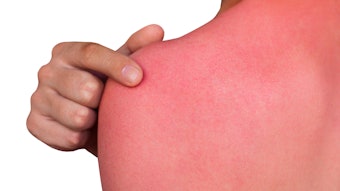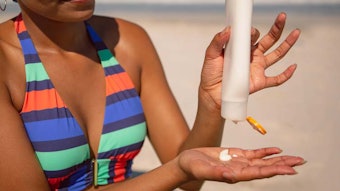The US Food and Drug Administration (FDA) recently released a statement in response to the Environmental Working Group's (EWG's) sunscreen report that claimed the FDA fails to set meaningful sunscreen standards...
The US Food and Drug Administration (FDA) is currently working on regulations for over-the-counter (OTC) sunscreen drug products that would address, among other things, UVA testing and SPF labeling issues. The regulation is currently in its final clearance.
Depending on its ingredients, a sunscreen product in the United Stated is regulated under either the new drug approval process, or under the OTC Drug Review ("monograph" system). Most sunscreens are regulated under the OTC monographs. The final monograph for sunscreen products was issued in May 1999 and can be found at: www.fda.gov/cder/otcmonographs/Sunscreen/sunscreen_FR_19990521.pdf
This final monograph is based on a previous series of proposals for which the FDA sought comment as early as 1978 and it specifies the ingredients allowed in sunscreens, testing requirements and labeling. This rule provides for SPF testing and "broad spectrum protection" labeling for products that absorb both UVA/UVB rays.
The FDA believes that approved sunscreens are safe and effective when used as directed. Sunscreens are an important part of a person's total sun protection strategy, but sunscreen use alone will not prevent all of the possible harmful effects due to sun exposure, according to agency statements. For more information, log on to the FDA Web site: www.fda.gov/cder/Offices/OTC/understanding_spf_sunscreen.htm
The FDA is one of the world leaders in standardizing UVA testing and labeling among sunscreen manufacturers. These benchmarks have helped to pave the way for the forthcoming regulations on UVA sunscreen products due out this year.
-Statement from the FDA
This follows a previous feature on CosmeticsandToiletries.com, reporting that the Environmental Working Group (EWG) recently surveyed the safety and efficacy of 785 sunscreen products in a database built to reportedly, "help fill the information gap caused by the [US Food and Drug Administration's] (FDA’s) failure to set meaningful sunscreen standards."
The survey of more than 700 brand-name sunscreens names products that the EWG says offer the best combination of safety and effectiveness, i.e.: they are formulated with the safest chemicals, are most effective at protecting against sunburn, and help to prevent long-term damage caused by the sun’s UVA rays, according to the EWG.
The analysis revealed that 84% of 785 sunscreen products with an SPF rating of 15 or higher offer inadequate protection from the sun’s harmful rays or contain ingredients with reported safety concerns. Some common sunscreen chemicals break down when exposed to sunlight and must be formulated with stabilizing chemicals while others penetrate the skin and present significant health concerns.
This research by EWG is based on nearly 400 peer-reviewed studies of the 17 sunscreen chemicals approved for use in the United States and an analysis of sunscreen ingredient toxicity linked to 60 industry and government databases on chemical hazards, coupled with customized, product-by-product assessments of protection from both UVA and UVB radiation.
“Always use sunscreen”, said Jane Houlihan, vice president for research at the EWG, in a press statement. “[B]ut not all sunscreens are created equal. Our research shows that some products are far more effective than others, while presenting fewer safety concerns."
Houlihan added that before the EWG launched this database, consumers had no way to identify the safest and most effective sunscreens. “The SPF rating on the product is helpful, but it is only part of what a consumer needs to know,” said Houlihan. “Our rating system includes critical information on UVA protection, how stable the product is in the sun, and potential health hazards of the product’s ingredients.”
“EWG has conducted this research because the FDA has failed to do so," said Houlihan in the press announcement. "With over one million cases of skin cancer reported each year, people should have the most reliable information available about which sunscreens will provide the best protection for themselves and their families.”
The report and online database rank products for combined safety and efficacy reportedly to help consumers recognize incorrect claims on sunscreen products and provide tips for safety in the sun. According to the EWG, the FDA has not finalized comprehensive sunscreen standards, which have been in development for 29 years. When complete, these rules will standardize a rating system for UVA protection and prohibit misleading and inaccurate claims such as “waterproof” and “lasts all day” that are commonly found on sunscreen products.
In a response statement to the EWG's report, the Cosmetic, Toiletry and Fragrance Association (CTFA) affirmed that the FDA's current regulations are strong and that, "consumers should have a high level of confidence that sunscreen products are safe and effective when used as directed."
"Sunscreens are an important tool for consumers and health professionals in the fight against skin cancer and other harmful effects of the sun," stated the CTFA. "While the final rulemaking is ongoing, there are currently strong FDA safety and effectiveness regulations that govern the manufacture and marketing of all sunscreen products. "
The CTFA added that the FDA requires significant safety and efficacy data on every active ingredient before it is approved for use in a sunscreen product and that the FDA has broad authority to inspect manufacturers, require strict manufacturing practices, and enforce rigorous, science-based regulations to ensure that sunscreen products are safe and effective for consumers.
The CTFA says it has worked closely with the FDA to ensure science-based regulations that protect consumers and ensure that sunscreens are safe and effective.










